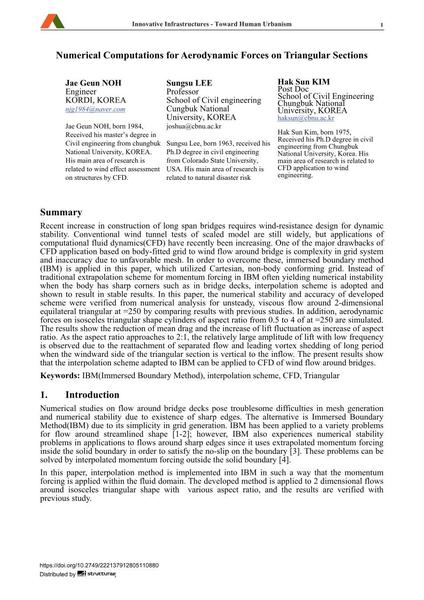Numerical Computations for Aerodynamic Forces on Triangular Sections

|
|
|||||||||||
Bibliographic Details
| Author(s): |
Jae Geun Noh
Sungsu Lee Hak Sun Kim |
||||
|---|---|---|---|---|---|
| Medium: | conference paper | ||||
| Language(s): | English | ||||
| Conference: | 18th IABSE Congress: Innovative Infrastructures – Towards Human Urbanism, Seoul, Korea, 19-21 September 2012 | ||||
| Published in: | IABSE Congress Seoul 2012 | ||||
|
|||||
| Page(s): | 555-561 | ||||
| Total no. of pages: | 7 | ||||
| DOI: | 10.2749/222137912805110880 | ||||
| Abstract: |
Recent increase in construction of long span bridges requires wind-resistance design for dynamic stability. Conventional wind tunnel tests of scaled model are still widely, but applications of computational fluid dynamics(CFD) have recently been increasing. One of the major drawbacks of CFD application based on body-fitted grid to wind flow around bridge is complexity in grid system and inaccuracy due to unfavorable mesh. In order to overcome these, immersed boundary method (IBM) is applied in this paper, which utilized Cartesian, non-body conforming grid. Instead of traditional extrapolation scheme for momentum forcing in IBM often yielding numerical instability when the body has sharp corners such as in bridge decks, interpolation scheme is adopted and shown to result in stable results. In this paper, the numerical stability and accuracy of developed scheme were verified from numerical analysis for unsteady, viscous flow around 2-dimensional equilateral triangular at =250 by comparing results with previous studies. In addition, aerodynamic forces on isosceles triangular shape cylinders of aspect ratio from 0.5 to 4 of at =250 are simulated. The results show the reduction of mean drag and the increase of lift fluctuation as increase of aspect ratio. As the aspect ratio approaches to 2:1, the relatively large amplitude of lift with low frequency is observed due to the reattachment of separated flow and leading vortex shedding of long period when the windward side of the triangular section is vertical to the inflow. The present results show that the interpolation scheme adapted to IBM can be applied to CFD of wind flow around bridges. |
||||
| Keywords: |
CFD IBM(Immersed Boundary Method) interpolation scheme Triangular
|
||||
